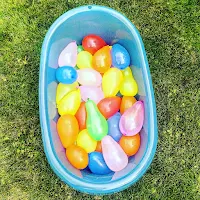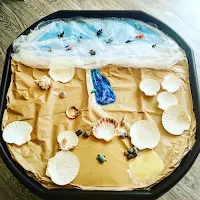 |
One of the biggest mistakes we can make as educators and/or parents of young children is planning for and seeing the outdoors as something entirely separate to the indoor setting. In the Early Years, wherever possible the outdoor area should be an extension of the indoor classroom - not a carrot dangled on a stick in the form of 'playtime', used as a reward once the more 'important' work and activities have been completed inside. Often, when 'outdoor play' is confined to short bursts, we see a lot of 'low level' learning taking place and 'playing around' rather than quality play - simply because the children don't have the time to engage in all of those important processes that result in quality learning and interactions, deep level learning and sustained shared thinking...
The fact that some children are often lead to the view that outdoor play, or 'playtime' is used as a 'reward' for those who have been 'good' ( as can often be assumed when children are made to miss playtime as a consequence) means that the idea of the learning environment outside being a useful and important learning tool for all children is diminished, and leads to a separation of 'work and play'... for young children, 'play' is how they learn. All work is play, and a good learning environment will allow for no separation between the two. Of course, a Forest School setting is the perfect answer to this, but not everyone has this option available to them.
This can be really tricky to manage (or to feel like you can manage) if you work in a setting with a high number of children per adult, such as a Reception class (where the 'legal' minimum is 30 children to one Teacher, but almost always includes one Teaching Assistant as well), it can often mean that in these situations, one member of staff stays in and one goes out. I've often heard this referred to as feeling a little bit like 'crowd control' and there are always concerns about certain groups of children who only ever want to play outside, missing out on indoor activities - please don't ever feel that this is a good reason to minimise outdoor play. If anything, this is an even greater reason for needing high quality resources, provocations and learning opportunities outside, completely separate and independent to the indoor learning but just as valuable.
I am not teaching in a setting at the moment, the majority of my teachable moments and activities with Arthur are planned and carried out at home, but I will admit that lately ( in spite of knowing all of the above) we haven't done as much outdoor play as we perhaps should have. Whereas once we would have had the patio doors open and ready for all manner of investigations (the ability for free flow is a massive advantage) my recent morning sickness and pregnancy nausea has meant that I've been working VERY hard on making indoor play seem super appealing (often with the help of Mr Tumble or Fireman Sam) whilst I've been convincing myself that the downstairs bathroom really isn't such a bad room to spend so much time. It can be hard to make a change, and for those who ARE working in a setting where outdoor play really is just low level playtime, it can be daunting to know just how to make a change. ( If you have a mud kitchen or are interested in reading WHY you should invest in one, how to use one and the resources required, have a read of my post on mud kitchen play here)
The best thing to do when attempting change and trying to encourage high levels of engagement within a larger group is to go with a WOW moment. Something that will kick off their interest straight away. Whether this is discovering that Goldilocks has stolen the porridge you'd left outside at lunchtime to cool down, finding a giant dinosaur egg or a spaceship has been left in the outside area or simply introducing a new and exciting piece of play equipment to spark their interest, the options are endless - but always remember to try and match this to the children's interests for maximum impact.
The best thing to do when attempting change and trying to encourage high levels of engagement within a larger group is to go with a WOW moment. Something that will kick off their interest straight away. Whether this is discovering that Goldilocks has stolen the porridge you'd left outside at lunchtime to cool down, finding a giant dinosaur egg or a spaceship has been left in the outside area or simply introducing a new and exciting piece of play equipment to spark their interest, the options are endless - but always remember to try and match this to the children's interests for maximum impact.
Buying resources for the Outside Area:
For Arthur, I decided to give this Wigwam a try from Big Game hunters. Their 'school play equipment' area on the website has some great resources for outdoor play, but you don't have to just be a school to order. It's super easy for settings and/or parents to order online which makes it a good choice to mention here as some of you may be looking for equipment for school, others for personal use at home. They DO have a dedicated EYFS section coming soon - hurrah! (yes, of course I asked - birth to five is THE most important period of learning and development for the brain) they are just working really hard at the moment to make sure this section is perfect.
It is worth noting here that delivery for this item was really fast and super organised - I was emailed upon dispatch and then given a time slot on the day so I could plan around this.
The thing that I like about this particular wigwam is that the canvas is made from wipe-able, waterproof calico cotton making it a perfect choice for outdoors and also indoors. I like the option of using this inside to carry on the learning experience if the weather outside is just too 'British' ! It was pretty simple to put together, the poles came in two separate parts which fit together with hard-wearing plastic connectors and are held together at the top with a thick string and wooden spacers. To be honest, the hardest thing for me was threading the string through the spacers and poles ( you'd think as an Early Years Teacher I'd have had plenty of threading practise!) but this became a bit more simple once I realised that the other end of the string was glued together and much more 'firm' to allow for an easy thread...I can use baby-brain as an excuse here right?!
Resources which help to promote imaginative play, such as this wigwam, are perfect for children of all ages. Arthur absolutely loves role play, and like most 2 year olds he loves little enclosed spaces to play, read, hide etc etc - the key is how you extend the learning by provocations, modelling and questioning - depending on what your focus is.
 |
| Our grass was a bit too muddy so we used the patio instead |
The thing that I like about this particular wigwam is that the canvas is made from wipe-able, waterproof calico cotton making it a perfect choice for outdoors and also indoors. I like the option of using this inside to carry on the learning experience if the weather outside is just too 'British' ! It was pretty simple to put together, the poles came in two separate parts which fit together with hard-wearing plastic connectors and are held together at the top with a thick string and wooden spacers. To be honest, the hardest thing for me was threading the string through the spacers and poles ( you'd think as an Early Years Teacher I'd have had plenty of threading practise!) but this became a bit more simple once I realised that the other end of the string was glued together and much more 'firm' to allow for an easy thread...I can use baby-brain as an excuse here right?!
 |
| This wigwam also works really well when carrying on the learning experience inside |
Resources which help to promote imaginative play, such as this wigwam, are perfect for children of all ages. Arthur absolutely loves role play, and like most 2 year olds he loves little enclosed spaces to play, read, hide etc etc - the key is how you extend the learning by provocations, modelling and questioning - depending on what your focus is.
The main areas of focus for this wigwam activity will be on the following Learning Areas:
(obviously other Learning areas will also be appropriate depending on how you extend the activity or use effective questioning)
Characteristics of effective learning - particularly 'Playing and Exploring':
Finding out and exploring:
•Showing curiosity about objects, events and people
•Using senses to explore the world around them
•Engaging in open-ended activity
•Showing particular interests
Playing with what they know:
•Pretending objects are things from their experience
•Representing their experiences in play
•Taking on a role in their play
•Acting out experiences with other people
Personal, Social and Emotional Development: Making relationships
•Interested in others’ play and starting to join in.
•Seeks out others to share experiences.
•Can play in a group, extending and elaborating play ideas,
e.g. building up a role-play activity with other children.
• Initiates play, offering cues to peers to join them.
•Keeps play going by responding to what others are saying or
doing.
•Demonstrates friendly behaviour, initiating conversations and
forming good relationships with peers and familiar adults.
Expressive Arts and Design: Being imaginative
•Engages in imaginative role-play based on own first-hand experiences.
•Builds stories around toys, e.g. farm animals needing rescue
from an armchair ‘cliff’.
• Introduces a storyline or narrative into their play.
•Plays alongside other children who are engaged in the same
theme.
•Plays cooperatively as part of a group to develop and act out
a narrative
Disclosure: I was sent this wigwam in return for an honest review.
You can read more of my Learning Through Play posts here:
And just in case you need a bit more inspiration for outdoor activities, here are some we have undertaken at home in the last 2 years:
Disclosure: I was sent this wigwam in return for an honest review.
You can read more of my Learning Through Play posts here:
 Learning through play
Learning through playFollow me:
Follow This post has been shared on some of these linkies: http://www.arthurwears.com/p/link.html

















